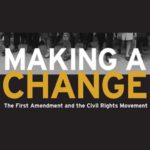The thoughts of the Founding Fathers never sounded so good in this rap “Let Me Believe” about our freedoms in the First Amendment. Three rappers who went on to win Constituting America’s Best Song in its We the Future contest provide a unique way to explain our freedoms. You have a video that is a teaching tool you have been seeking to help students understand the First Amendment.
Freedom of the Press
Students explore the scope and limitations of the First Amendment provision that protects freedom of the press. The lesson poses a hypothetical scenario involving student journalists handling private information. After a brief class discussion, students investigate the history, various interpretations, and modern relevance of First Amendment freedom of the press protections in the Interactive Constitution. The lesson builds on the freedom of speech lesson plan by asking students to compare and contrast the freedoms of speech and press through discussion questions including: How are speech and press related? and How are speech and press key to democratic functions?
‘If You Had Something Powerful’
“If You Had Something Powerful” is Constituting America’s Best High School PSA winner, created by Laura Leigh Hicks. We all have something that we love treasure, rely on, others want, others died for, all put in a document for us. This We the Future Contest video explains the freedoms we love and challenges students to now read it. All this in a one-minute PSA.
Free Speech Essentials
Do your students know what they’re free to say online? At school? On a public street corner? From censorship to cyberbullying, the First Amendment and the freedoms it protects are as hotly contested as ever. This EDCollection explores 16 free speech debates ranging from the founding of our nation to recent headlines to illustrate what free speech actually means, where it comes from, and how far it can go. Whether you’re a social studies teacher looking for a complete unit or an English teacher looking to spend a single class period on free expression, there’s something for everyone. Free registration required.
Dialogue on the Fourteenth Amendment
The American Bar Association Dialogue program provides lawyers, judges and teachers with the resources they need to engage students and community members in a discussion of fundamental American legal principles and civic traditions. This Dialogue on the Fourteenth Amendment is composed of three parts:
Part 1: Equal Protection and Civil Rights – Participants discuss the equal protection clause of the 14th Amendment and consider how Congress, through federal legislation, has worked to help realize its constitutional promise.
Part 2: Incorporating the Bill of Rights examines the concept of incorporation. Using a case study of Gitlow v. New York, this section provides a guide to how courts have applied the Bill of Rights, selectively, to the states using the 14th Amendment.
Part 3: Ensuring Equality and Liberty explores how the 14th Amendment has been interpreted by courts to protect fundamental freedoms, including individuals’ right to marry.
Introducing the First Amendment
Students will inductively discover the First Amendment by reading and analyzing newspapers. They will discuss various circumstances involving the First Amendment, and so understand that in certain instances – libel, publication of national secrets, etc. – there is a limit to the freedoms expressed in the First Amendment.
Teaching About Due Process and the Law
In this lesson, students will be presented with various cases of discrimination. They will identify the discriminatory practice, and discuss the difference between permitted and illegal discrimination. The instructor might then lead discussion about the difficulties in drafting laws that ensure no discrimination while not interfering too much with private citizens’ freedoms.
Making a Change: The First Amendment and the Civil Rights Movement

Delve into hundreds of historical newspapers, videos, photographs and more to find out how the five freedoms empowered people fighting for change — and those fighting against it. Topics include: the history of the American civil rights movement, the relationship between the movement and the news media, the evolution and application of First Amendment freedoms, bias in the news, civic engagement and more.
1798: Sedition Act Reins in Newly Established Freedoms
Prominent Republican Party members immediately denounce the Act as a violation of First Amendment freedom of speech and of the press, but the Federal courts move forward with cases brought under the law. The still-new nation is drawn into a tense debate: To what extent should the government of a young nation limit criticism of its leaders and policies to protect its stability in the face of foreign threats?
Fundamental Freedoms
This lesson uses three Supreme Court cases to illustrate the difficulty in balancing our rights as citizens with the authority of a governmental body. Students will learn what our rights are, where they come from, and how far they extend.